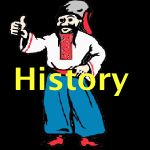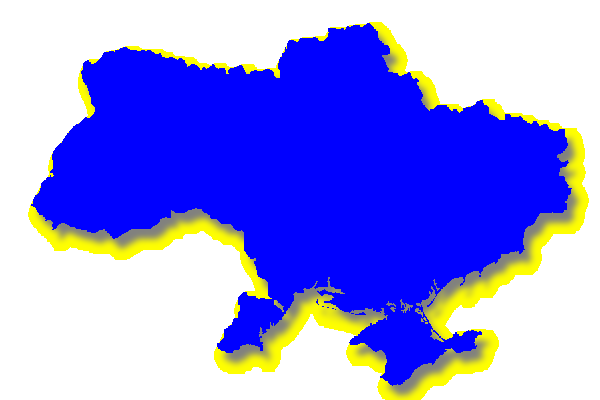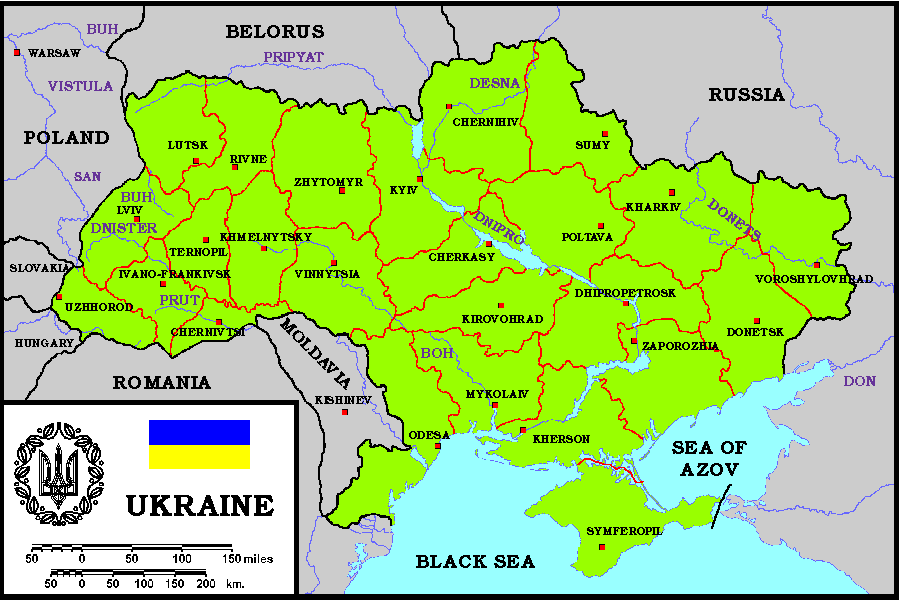Ukrainian history began with the Scythians who dominated the steppes north of the Black Sea from the 7th to the 4th centuries BC, initiating centuries of outside political and cultural domination. Traces of Scythian culture can be found in Kyiv's Caves Monastery, where the tombs contain superb goldwork depicting highly detailed animal and human forms. Following the Scythians, a series of invaders, including Ostrogoths, Huns and the Turko-Iranian Khazars, ruled areas of present-day Ukraine. The first people to unify and control the area for a long period were Scandinavians known as the Rus. The Rus took Kyiv in 882 AD, and by the late 10th century the city was the centre of a unified state known as Kyivan Rus, which stretched from the Volga west to the Danube and south to the Baltic. In 988, the Kyivan Rus leader Volodymyr accepted Christianity from Constantinople, beginning a long period of Byzantine influence over Ukrainian politics and culture. Batu, a grandson of Genghis Khan, sacked Kyiv in 1240. Kyiv never fully recovered from Batu’s blow and the seat of Rus power shifted to western Ukraine centered on Lviv. Southern Ukraine devastated by Batu and almost empty of population was referred to as borderland, the word Ukraine means borderland. After Batu the Golden Horde dominated what is now Ukraine and Russia for three centuries. Moscow at this time was just a minor outpost and was of no significance till the fifteenth century. By 1520 the Ottomans Empire controlled all of coastal Ukraine. Military devastation and plague had wiped out much of the population of the Ukrainian steppe by the 15th century, when the region became popular with runaway serfs and Orthodox refugees escaping more tightly controlled neighbouring domains. These people came to be known as kazaks (Cossacks), a Turkish word meaning outlaw, adventurer or freebooter. Ukrainian Cossacks eventually formed a state that, although officially under Polish and later Russian rule, was to a significant degree self-ruling, but eventually the state was divided between Poland and Russia. Ukrainian nationalism flourished in the 1840s, prompting Russian authorities to ban the Ukrainian language in schools, journals and books. Following WWI and the collapse of tsarist authority, Ukraine finally had a chance to gain its independence, but none of the bewildering array of factions could win decisive support. Civil war broke out and the country quickly descended into anarchy, with six armies vying for power and Kyiv changing hands five times in one year. After prolonged fighting involving Russia, Poland and various Ukrainian political and ethnic factions, Poland retained portions of western Ukraine and the Soviets got the rest. Ukraine officially became part of the USSR in 1922. While the leadership in Moscow sorted itself out, another Ukrainian national revival took off in the 1920s.When Stalin took power in 1927, however, he made a test case out of Ukraine for his ideas about 'harmful' nationalism. In 1932-33 he engineered a famine that killed as many as 7 million Ukrainians. Execution and deportation of intellectuals further depopulated the country. Stalin also went after the country's premier religious symbols, its churches and cathedrals, destroying over 250 buildings. During the purges of 1937-39, millions more Ukrainians were either executed or sent to Soviet labor camps. WWII brought further devastationand death, with 6 million perishing in the fighting between the Red Army and the German forces. It's estimated that during the first half of the 20th century, war, famine and purges cost the lives of over half the male and a quarter of the female population of Ukraine. The 1986 Chernobyl disaster in Ukraine and the appallingly slow official Soviet response provoked widespread discontent, and the Uniate Church emerged from isolation two years later. The Ukrainian People's Movement for Restructuring, an umbrella nationalist movement founded in Kyiv by prominent intellectuals and writers, won local seats across the country in 1990. In July of that year, the parliament issued a sovereignty- but not secession - declaration to little effect. Shortly after the failed Soviet coup in August 1991, the Communist Party of Ukraine (CPU) was banned, and in December the population voted overwhelmingly for independence. Leonid Kravchuk, former chairman of the CPU, was elected as the first president of Ukraine. Factionalism forced the government's resignation in September 1992, and disagreements with Russia over Ukraine's cache of inherited nuclear weapons and control of the Black Sea fleet (harboured in the Crimean port of Sevastopol) strained relations between the two countries. Meanwhile, skyrocketing inflation, fuel shortages and plummeting consumer power plagued the country and exacerbated regional and ethnic differences. Pro-Russian reformer Leonid Kuchma beat Kravchuk in the 1994 presidential election. The CPU benefited from the political and economic turmoil, capturing a substantial majority of parliamentary seats in the 1994 elections. In the late 1990s, new tensions arose between Ukraine and Russia over Ukraine's closer ties with NATO. For decades, the Western world perceived Ukraine as simply apart of Russia. But borscht, painted eggs and many of the famous Cossack song and dance traditions originated in Ukraine. Western Ukrainians consider themselves to be 100% Ukrainian and the vanguard of their culture, speaking their language and trumpeting their nationalism. In the east, where over 10 million ethnic Russians live, nationalism is less intense, and most people speak Russian. Ukrainian, like Russian and Belarusian, is an Eastern Slavic language. It's arguably the closest of the three to the original 9th century Slavonic used in Kyiv before the more formal Church Slavonic from Bulgaria was introduced with Christianity in the 10th century. Despite being watered down by Russian and Polish and being banned by Tsar Alexander II in 1876, the Ukrainian language persevered and is becoming more widespread. It was adopted as the country's official language in 1990, though Russian is understood by everyone. The origins of Ukraine's national literature go back to medieval Slavic chronicles such as the 12th century Slovo o polku Ihrevim (The Tale of Ihor's Armament). The beginnings of modern Ukrainian literature stem from mid-18th century wandering philosopher Hryhorii Skovoroda, the 'Ukrainian Socrates'. Skovoroda wrote poems and philosophical tracts in Ukrainian, aimed at the common person rather than the elite. Taras Shevchenko, an ardent nationalist who was born a serf in 1814 and became a national hero, was the first major writer in Ukrainian. His work launched a golden age of Ukrainian literature. The most talented and prolific writer of the early 20th century was Ivan Franko, whose work spanned fiction, poetry, drama, philosophy andchildren's stories. Many writers made the Soviet occupation their subject, andmany suffered for it. Vasyl Stus' Winter Trees (1968) and Candle in the Mirror (1977) set the agony of dissidence to poetry; Stus eventually was killed in a Soviet labour camp. The Union of Ukrainian Writers in Kyiv was instrumental in bringing about independence from the USSR in 1991. Ukrainian music has its roots in centuries-old oral traditions of bylyny (epic narrative poems) and dumas, which were long lyrical ballads glorifying the exploits of the Cossacks. The roots of Ukrainian folk music lie in the legendary kobzar, wandering minstrels of the 16th and 17th centuries who accompanied their songs of heroic exploits (mostly of the Cossacks) with the kozba, a lute-like instrument. The bandura, a larger instrument with up to 45 strings, replaced the kozba in the 18th century. Bandura choirs were soon all the rage, and the instrument became the national symbol. Today, the Ukrainian Bandura Chorus from Kyiv performs worldwide. Mykola Lysenko is probably the best known Ukrainian classical composer, famous for basing piano works on Ukrainian folk songs. Popular contemporary musicians include the punk band Plach Yeremiyi and the singer-songwriter Nina Matvienko, who draws heavily on Ukrainian folk traditions. Christianity came to Ukraine late in the 10th century. The Catholic and Orthodox churches split in 1054, and Orthodoxy itself later split into three main branches, each one with a different relationship to Moscow-controlled Russian Orthodoxy and to Roman Catholicism. Church buildings dominate Ukrainian architecture. One unique genre is the wooden church, featuring gables and wooden-shingled onion domes and cupolas - all held together by complex joinery without nails. As part of their campaign to crush Ukrainian identity and nationalism, the Soviets demolished hundreds of sacred buildings in the 1930s, including four 12th century cathedrals. Painting also has its roots in religious themes. Until the 17th century, the key expression was the icon - a small image of Christ, the Virgin, angels or saints, painted on a lime wood panel and attributed with healing and spiritual powers. Church murals, mosaics, frescoes and illuminated manuscripts developed at the same time as the icon.The rise of the Cossacks in the 17th century stimulated new schools of secularpainting with nationalist themes. After the deadening chill of decades of Soviet Realism, stylistic experimentation and nationalist themes are once again rampant. Ukrainian cuisine stems from peasant dishes based on grains and staple vegetables like potatoes, cabbage, beets and mushrooms. Meat is typically boiled, fried or stewed. Desserts are usually laden with honey and fruit, mainly cherries and plums, and often baked into sweet breads. While the small dumplings known as varenyky are by far the most popular Ukrainian snack, the sacred dish is salo - pig fat. Salo consumption goes back centuries,and Ukrainians age and prize it as obsessively as the French do wine. Borscht originated in Ukraine and is still the national soup; the beet and mixed-vegetable broth is typically served with cream. Ironically, good Ukrainian food is hard to find in Ukraine, as most top-end restaurants serve trendy Euro cuisine. The best Ukrainian cooking is found in the home; if you get invited to someone's house for a meal, you're in for a treat.
|
|



